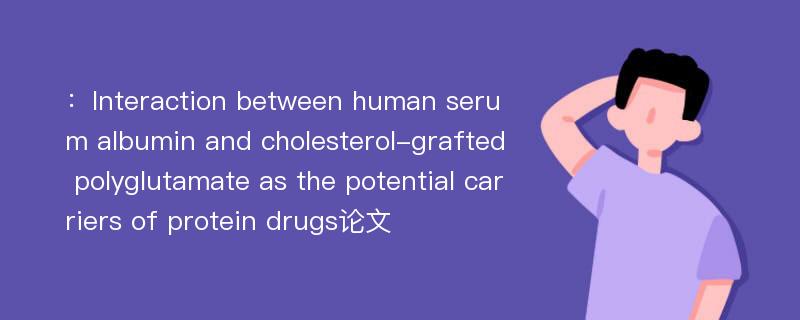
本文主要研究内容
作者(2019)在《Interaction between human serum albumin and cholesterol-grafted polyglutamate as the potential carriers of protein drugs》一文中研究指出:Currently there is no successful platform technology for the sustained release of protein drugs.It seems inevitable to specifically develop new materials for such purpose, and hence the understanding of protein–material interactions is highly desirable. In this study, we synthesized cholesterol-grafted polyglutamate(PGA-g-Chol) as a hydrophobically-modified polypeptide, and thoroughly characterized its interaction with a model protein(human serum albumin) in the aqueous solution by using circular dichroism, fluorescence methods, and light scattering. With the protein concentration fixed at 5 μmol/L,adding PGA-g-Chol polymers into the solution resulted in continuous blue shift of the protein fluorescence(from 339 to 332 nm), until the polymer molar concentration reached the same value as the protein. In contrast, the un-modified polyglutamate polymers apparently neither affected the protein microenvironment nor formed aggregates. Based on the experimental data, we proposed a physical picture for such protein–polymer systems, where the polymer first bind with the protein in a 1:1 molar ratio via a fraction of their hydrophobic pendant cholesterol resides along the polymer chain. In this protein/polymer complex, there are excess unbound cholesterol residues. As the polymer concentration increases, the polymers form multi-polymer aggregates around 200 nm in diameter via the same hydrophobic cholesterol residues. The protein/polymer complex also participate in the aggregation via their excess cholesterol residues, and consequently the proteins are encapsulated into the nanoparticles. The encapsulation was also found to increase the thermal stability of the model protein.
Abstract
Currently there is no successful platform technology for the sustained release of protein drugs.It seems inevitable to specifically develop new materials for such purpose, and hence the understanding of protein–material interactions is highly desirable. In this study, we synthesized cholesterol-grafted polyglutamate(PGA-g-Chol) as a hydrophobically-modified polypeptide, and thoroughly characterized its interaction with a model protein(human serum albumin) in the aqueous solution by using circular dichroism, fluorescence methods, and light scattering. With the protein concentration fixed at 5 μmol/L,adding PGA-g-Chol polymers into the solution resulted in continuous blue shift of the protein fluorescence(from 339 to 332 nm), until the polymer molar concentration reached the same value as the protein. In contrast, the un-modified polyglutamate polymers apparently neither affected the protein microenvironment nor formed aggregates. Based on the experimental data, we proposed a physical picture for such protein–polymer systems, where the polymer first bind with the protein in a 1:1 molar ratio via a fraction of their hydrophobic pendant cholesterol resides along the polymer chain. In this protein/polymer complex, there are excess unbound cholesterol residues. As the polymer concentration increases, the polymers form multi-polymer aggregates around 200 nm in diameter via the same hydrophobic cholesterol residues. The protein/polymer complex also participate in the aggregation via their excess cholesterol residues, and consequently the proteins are encapsulated into the nanoparticles. The encapsulation was also found to increase the thermal stability of the model protein.
论文参考文献
论文详细介绍
论文作者分别是来自Acta Pharmaceutica Sinica B的,发表于刊物Acta Pharmaceutica Sinica B2019年01期论文,是一篇关于,Acta Pharmaceutica Sinica B2019年01期论文的文章。本文可供学术参考使用,各位学者可以免费参考阅读下载,文章观点不代表本站观点,资料来自Acta Pharmaceutica Sinica B2019年01期论文网站,若本站收录的文献无意侵犯了您的著作版权,请联系我们删除。
